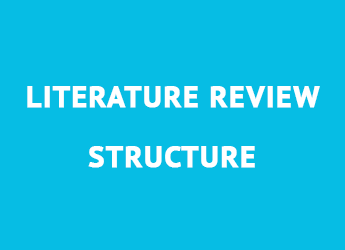Do you have to write a literature review? Then you are in the right place. We will disclose the meaning and the essence of this academic writing and provide you with guidelines on its writing. This part of the Ph.D. dissertation is often compared with a list of references. It also collects the used materials and sources of the information and presents them in a logical sequence. This is an important part of the dissertation as here you show how much information you have analyzed in order to disclose the topic to the fullest and fill in the gaps in knowledge of some matters.
In order to bring up the right impression of your work, your literature review section should be in the proper format, content and logical. You can free some time if you will delegate this task to the professional writing services. However, we are sure that our tips and examples will help you in doing this task without any help.
Literature Review Structure Example
In order to create the right literature review, you should identify its main purposes. But this insight will bring you only half of success. The other half lies in your skills and ability to follow the particular structure. It will be easier for you to keep in mind the right structuring if you will have a few good examples. In fact, it is pretty similar to the typical essay structure. Knowing and understanding how to work in the literary review will assure that the process will be easy and without any stress. It will not be a challenge for you. But we still want to provide you with all possible options to level up your skills. So we have prepared the plan you can use to make your review designed perfectly.
It will have three main elements that are similar to all the academic writings’ constituents. They will not probably be new to you: the introduction, the body, and a conclusion. Below you will find the short description and recommendations for each of them.
1. An Intro Part
If you want to start your text in a proper way, you need to make sure that it will be written in accordance with the following requirements:
- Presenting an understandable and clear description of the paper’s purpose and moving the content towards the logical review.
- Demonstrating the goals and views of the author.
- Pointing out the selected approaches and methods.
- Transiting your point to the ideas from the main part.
2. A Body Part
This part will have the following specifications:
- Performing an organized list of sources that are presented in chronological order;
- Explaining the importance of the different source categories and they all are connected to the topic.
3. A Conclusion Part
The final section recommendations:
- Summarize the most crucial points you have discovered from the presented literature;
- Estimate the quality of references you have made;
- Point out the gaps you have discovered during your research;
- Suggest the solution for the spotted issues in the future researches of the topic;
- Describe the significance of your discoveries for filling in the presented gaps.
This is an example of the basic review essay structure. You can use it as a guiding line to start your essay to complete your task quicker and more correct.
Methods for Structuring Literature Reviews
You may be surprised by the fact that the proper structure approach can drastically improve your research and writing process. Do not be among those students who consider that they can keep in mind the logic of their research and present the results of it in an understandable way. We have prepared the description of two methods you can use for writing a literature review: the thematic and chronological approaches in order to help you to use it in the most effective way.
1. The Thematic approach
This method is focusing on arranging and grouping the materials and literature sources according to their topics. You also can group the sources according to their importance. This approach is very popular among students. They prefer it instead of the chronological one. For students, it helps to provide a deep analysis of the topic before grouping materials and to acquire a deeper understanding of the research topic of investigation. You also might need to explain your decision to combine the particular parts and prove the unique name for the category. Also, your task will be choosing the right sequence. It is up to you, but we recommend to arrange them according to the significance of the source to the disclosing the topic.
2. The Chronological approach
This way is clear and understandable to most of the students as the only thing you should take into consideration is the date of publication of the piece of literature. But if you want to point out the significance of your list of literature to the topic research, you should probably appeal to the first option. However, this method will be suitable for historical works, for instance, where the data is presented in a chronological sequence anyway.
Now you know the basic approaches for organizing your literature reviews. But in any case, you should remember that each method requires using the transitional words and connecting thought in a logical sequence, understandable to the target reader. You should realize that this is not a simple listing, but the opportunity to showcase the depth of your investigation of the topic.



